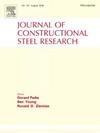Investigation into welding residual stress of high-performance-steel Q500qE welded-joint
IF 4
2区 工程技术
Q1 CONSTRUCTION & BUILDING TECHNOLOGY
引用次数: 0
Abstract
This study investigates the welding residual stress (WRS) spatial distribution in a high-performance steel (HPS) Q500qE unequal-thickness butt-welded joint of steel bridge tower. The hole-drilling and contour methods were used to measure the initial residual stress (IRS) of the base material and WRS in the welded joint. Additionally, the welding process was simulated using ABAQUS, incorporating IRS of base material to study WRS of welded joint. The comparison between measured and simulated WRS showed good agreement, validating the simulation's effectiveness and accuracy. The results reveal that simulated longitudinal and transverse WRSs (LWRS and TWRS) on the top and bottom surfaces indicate high tensile stresses in the weld region, exceeding the measured yield strength of the Q500qE steel. These stresses decrease and transition to compressive states as the distance from the weld increases. LWRS contours show a high tensile stress region along the plate thickness in the weld. Away from the weld, the LWRS is compressive at the surface layer and tensile in the interior zone, especially in the 56 mm-thick base material. The simulated TWRS shows high tensile stress primarily at the weld surface layer, with compressive stress mainly in the surface layer of the 56 mm-thick base material. Compared to vertical WRS (VWRS), the simulated LWRS and TWRS with IRS show higher stress levels and significant stress gradients.
高性能钢 Q500qE 焊接接头的焊接残余应力研究
本研究探讨了高性能钢(HPS)Q500qE 不等厚对焊钢桥塔接头中焊接残余应力(WRS)的空间分布。采用钻孔法和等高线法测量了母材的初始残余应力(IRS)和焊接接头中的 WRS。此外,还使用 ABAQUS 模拟了焊接过程,并结合母材的 IRS 研究了焊接接头的 WRS。测量和模拟的 WRS 比较显示出良好的一致性,验证了模拟的有效性和准确性。结果显示,顶部和底部表面的模拟纵向和横向 WRS(LWRS 和 TWRS)表明焊接区域的拉伸应力很大,超过了 Q500qE 钢的实测屈服强度。随着与焊缝距离的增加,这些应力逐渐减小并过渡到压缩状态。LWRS 等值线图显示了焊缝中沿钢板厚度方向的高拉伸应力区域。在远离焊缝的地方,LWRS 在表层为压应力,而在内部区域为拉应力,尤其是在 56 mm 厚的母材中。模拟 TWRS 主要在焊缝表层显示出较高的拉应力,而压应力主要在 56 mm 厚母材的表层。与垂直 WRS(VWRS)相比,带有 IRS 的模拟 LWRS 和 TWRS 显示出更高的应力水平和明显的应力梯度。
本文章由计算机程序翻译,如有差异,请以英文原文为准。
求助全文
约1分钟内获得全文
求助全文
来源期刊

Journal of Constructional Steel Research
工程技术-工程:土木
CiteScore
7.90
自引率
19.50%
发文量
550
审稿时长
46 days
期刊介绍:
The Journal of Constructional Steel Research provides an international forum for the presentation and discussion of the latest developments in structural steel research and their applications. It is aimed not only at researchers but also at those likely to be most affected by research results, i.e. designers and fabricators. Original papers of a high standard dealing with all aspects of steel research including theoretical and experimental research on elements, assemblages, connection and material properties are considered for publication.
 求助内容:
求助内容: 应助结果提醒方式:
应助结果提醒方式:


